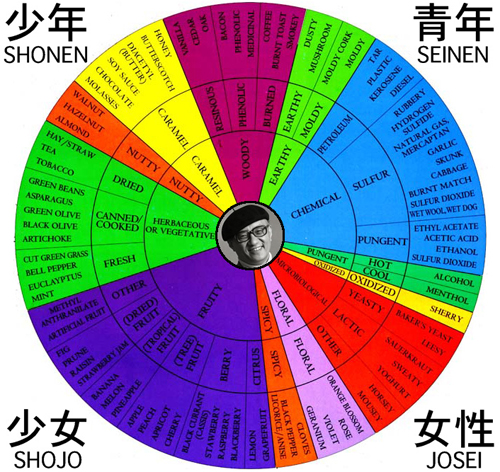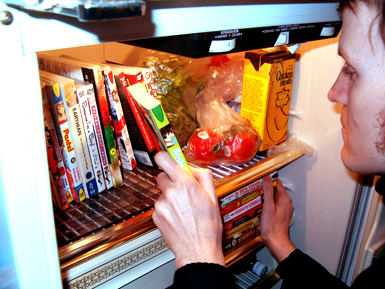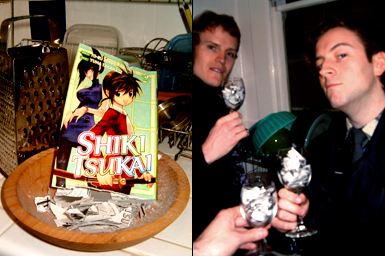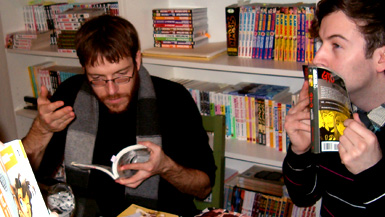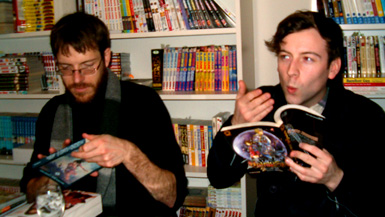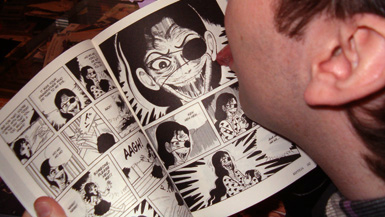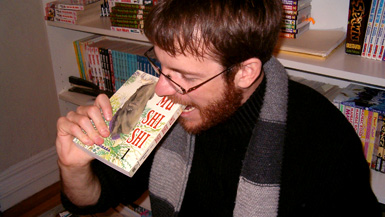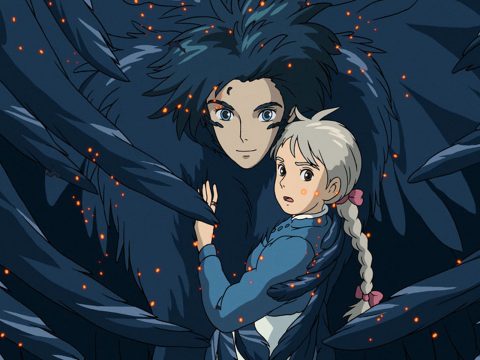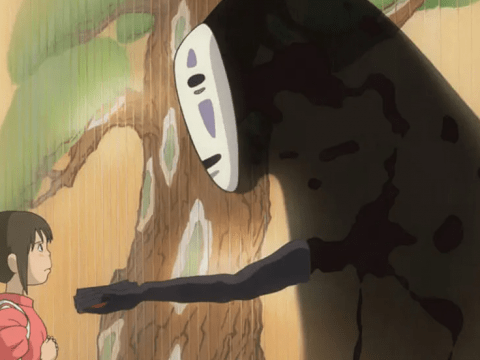The modern system of manga categorization was developed
by Osamu Tezuka over a few cases of Franzia in 1963.
Each day in America, thousands of manga are read, and hundreds of manga reviews go up on the Internet. Half of these reviews are deleted by librarians after the reviewer uses up their 15 minutes on the terminal. And yet, even the remaining manga reviews generally all rate manga according to the same narrow criteria: is the art good? Is the story interesting? Is there an anime I can watch instead? Do the characters have cat ears?
Where do you go to review manga? Some manga publishers, such as Viz and Vertical, now offer manga tastings to anyone who walks into the building. (Tell them Otaku USA sent you.) Many chain bookstores also offer informal manga reviewing in the form of understaffed manga aisles. However, the easiest solution of all is to host a manga tasting in your own home. For my own tasting, I invited over Jake Forbes (https://www.gobblin.net), freelance manga editor and author of Return to Labyrinth, and Ryan Sands (samehat.blogspot.com), tech-industry power broker and underground manga translator. Manga is best shared between friends. Clear enough manga off the chairs so people can sit down and prepare for an afternoon or evening of olfactory gratification.
How to keep your manga
In most circumstances, manga can be kept on ordinary bookshelves and read at room temperature. However, some manga is best kept chilled. As a rule, the sweeter the manga, the colder it should be. Thus, 14-18 degrees Celsius (58-65 Fahrenheit) is an ideal temperature for serving shojo and josei manga. For sparkling shojo and magical girl manga (Shugo Chara!, Sailor Moon, Wedding Peach, etc.) the temperature should be lower. If the pages will not open, the manga has been over-chilled, or alternately it may be an ero-manga. A few shonen manga also require chilling.
Preparing manga for reviewing
The Tasting
And so it begins! Reviewing a manga-enjoying it with all your senses-requires four distinct stages. The business of reviewing a manga is nothing more than weighing the pleasure you find in each of these factors.
(1) The “eye” (appearance)
The visual aspect of the manga. Does the cover look good? Are there interior color pages? Does it have that pink paper? A manga’s color is best judged by putting it against a white background. Similarly, the quality of the art is best judged by putting it next to a copy of Medabots or Hibiki’s Magic, and the story is best judged by putting it against a copy of Haruka: Beyond the Stream of Time. Observe the color and sparkle of the manga.
(2) The “Nose” (Fragrance)
Begin by sniffing the manga. Sniff it. Don’t inhale it in a furious snort. Hold the manga three or four inches below your nose, remove the shrinkwrap if necessary, and gingerly take in two or three whiffs of the perfume. Hold those little whiffs in your nose until you feel them ooze into the back of your throat. Exhale completely and swallow, freeing your head of the manga completely. Then ram your face into the manga, bending the spine back as far as possible, until your entire nose and mouth are embedded in manga and you will be unable to return it to the store. Toss your neck about as you nuzzle the manga like a blind baby kitten searching for its mother’s nipple. One deep breath of a fine manga is hardly enough. Why not enjoy such a pleasure? Breathe again. You may discover a few delightful sensations you missed the first time.
(3) The Palate
Next, take a good, bold sip of the manga. Hold it firmly in your mouth. You will notice at once that the manga is actually inside your mouth. You seem to be feeling the smell of the manga as though the smell were tangible. Alternately, you can lick around the outside of the manga. Does the paper remain firm to the touch, or does it tremble and soften? Indulge the acidic, bitter sensation of the ink and the woodsy, oaky flavor of the pulp. Now slurp the manga around in your mouth as you set about judging the body of the manga. That slurping, complete with whatever gurgling sounds it may produce, is an essential part of manga reviewing. The fanservice (in shojo manga, the bishonen elements) is what causes the faintly burning sensation, which now fills the mouth. It appears to give the manga a feeling of substance or lack of substance.
(4) The Story
You read the manga; and what is left is the finish, or “aftertaste.” This is quite often the most dazzling part of manga reviewing.
WARNING: Professional manga reviewers generally spit out the manga after they have assessed its quality, rather than reading the whole thing. The average Japanese person only keeps a page of manga in their mouth for 5 seconds! Trying to read too much manga in one sitting — too many spiky-haired boys who want to be the best, and insecure girls who just want a normal high school life — will impair your judgment and potentially give you a hangover. If you are at a manga tasting, ask your host for a spittoon, or ask where to dispose of previously read manga. It is not considered rude to spit out manga, even in the presence of the manga author or publisher.
We sampled a variety of manga, tasting both old and new vintages and publishers. For the final reviewing, of course, we served the manga “blind.” A manga reviewer’s judgment can be prejudiced by knowing details of a manga, such as geographic origin, price, reputation, Wikipedia entry, or other considerations. When given manga that they are falsely told is “unflopped” they virtually always report it as tasting better than the very same wine when they are told that it is “flopped.” A similar effect takes place when reviewers are given manga that they are falsely told is “licensed by Viz.”
The two aspects of all manga are “character” and “complexity.” A manga reviewer also looks for integration, which is a state in which none of the components of the manga (fight scenes, panty shots, references to the Kabbalah, etc.) is out of balance with the other components. When a manga is well balanced, it is said to have achieved a harmonious fusion. Expressiveness is the quality the manga possesses when its aromas and flavors are well defined and clearly projected. The connectedness of the manga, a rather abstract quality, is connected to the bond between the manga and the land where it comes from. Some reviewers say that the best manga comes from Japan. Others broaden the definition of manga to include Korea, or Sonoma and Napa County in California. After some consideration we selected eight manga for fuller analysis.
 SHONEN JUMP MAGAZINE
SHONEN JUMP MAGAZINE
2007 VIZ
JASON: Sort of the Charles Shaw of manga. For its price, it yields a rich, oaky bouquet of flavors, with a slight aftertaste of cross promotion.
JAKE: Don’t let the big box and low price fool you; there’s some good grapes in here.
RYAN: Its admirable finish is varied, long and devoid of the pastiness and aromatic warmth I found in some manga magazines. Anticipated maturity: now to 2012.
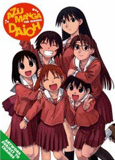 AZUMANGA DAIOH OMNIBUS
AZUMANGA DAIOH OMNIBUS
2000 ADV
RYAN: I was shocked that despite such a large body, it has a crisp sweetness like fine beer and pulp.
JASON: A sweet manga with a round, soft body, initially yeasty, accompanying notes of smoke and vanilla.
JAKE: A triumph of finesse, freshness and vivacity this is not, but the sparkly sweetness makes this a fun manga for sipping. Be warned-can yield a nasty hangover.
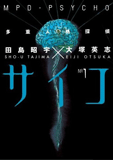 MPD PSYCHO
MPD PSYCHO
1998 DARK HORSE
JAKE: An explosive blend of kerosene, sulfur dioxide and cabbage that is at first almost unquaffable, but the taste buds become desensitized after multiple sips. A good manga to get drunk on, but doesn’t pair well for meals.
RYAN: After an initially powerful whiff of maturity, it unfortunately left me with a compressed and hollow aftertaste. That said, I see it as a sleeper hit of the 2007 vintage among troubled and adventurous manga fans.
JASON: Very elegant and rich, almost too rich, distinguished by dominant aromas of fresh red fruit (blackberry, myrtle, blackcurrant) and a strong scent of petroleum. Floral notes similar to violets are the mark of Dark Horse seinen manga. Age adds more distinctive note of empyreuma and especially nuances of baked or crystallized fruit such as morello cherry or cherries in brandy.
 REPTILIA
REPTILIA
1965 IDW
JAKE: The sleeper of the vintage…it’s got a lot of body to it. Almost a prunelike odor.
RYAN: A persistent woodiness belies the tart underlying smoky aroma.
 DARK ANGEL
DARK ANGEL
1992 CPM
JAKE: I was floored by the overexpressive nose, and not in a good way. A very weak-structured manga that will leave you sick before it leaves you drunk; best shelved somewhere between Bomber Girl and a bottle of Blue Nun.
JASON: This acidic manga carries a faint scent of tannins, but in the end, leaves an unsatisfying impression.
RYAN: A dry and hollow manga smell, without the expressiveness I so love.
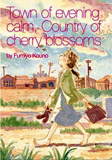 TOWN OF EVENING CALM, COUNTRY OF CHERRY BLOSSOMS
TOWN OF EVENING CALM, COUNTRY OF CHERRY BLOSSOMS
2003 LAST GASP
RYAN: The bold ink leapt out at me with short (but ashy) aromatics, complex flavors and impeccable equilibrium.
JASON: A concentrated chemical smell, with overtones of sulfur, and a ripe, tannin-packed finish. On the palate, this deep and rich effort is packed with menthol and mushroom.
JAKE: A wispy berry skillfully blended with rich tannins that should help it age well.
 ROBOT
ROBOT
2004 DMP
JAKE: It’s a little green like a wine made from unripe fruit… and yet rather sweet… it could be a good dessert manga. A little bit goes a long way, kind of like a $6 bottle of Riesling.
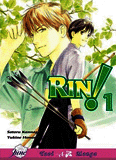 RIN!
RIN!
2002 DMP
JAKE: As someone who’s new to this variety, I find it surprisingly tame and a very mild flavor. I was expecting a bold taste explosion in my mouth, but it goes down surprisingly easy.
RYAN: A lean body, but not yet a mature and balanced finish.
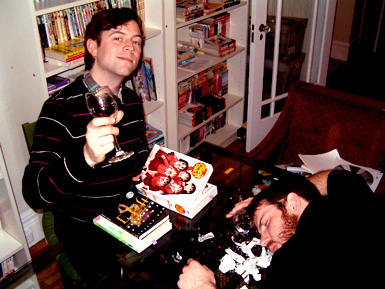
* Many thanks to Jake Forbes and Ryan Sands.


